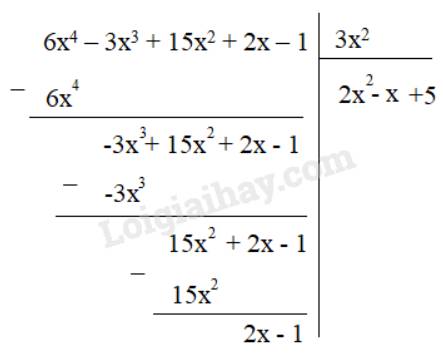Cho f(x)+g(x)=6x4-3x2-5
f(x)-g(x)=4x4-6x3+7x2+8x-9
Tim f(x),g(x)
Cho các đa thức:
F(x)=4x4-2+2x3+2x4-5x+4x3-9
G(x)=6x4+6x3-x2-5x-27
a) Thu gọn và sắp xếp các hạng tử F(x) theo lũy thừa giảm của biến
b) Tính K(x)=F(x) + G(x)
c) Gọi H(x)=F(x) - G(x). Chứng minh đa thức H(x) vô nghiệm
`a,`
`F(x)=4x^4-2+2x^3+2x^4-5x+4x^3-9`
`F(x)=(2x^4+4x^4)+(2x^3+4x^3)-5x+(-2-9)`
`F(x)=6x^4+6x^3-5x-11`
`b,`
`K(x)=F(x)+G(x)`
`K(x)=(6x^4+6x^3-5x-11)+(6x^4+6x^3-x^2-5x-27)`
`K(x)=6x^4+6x^3-5x-11+6x^4+6x^3-x^2-5x-27`
`K(x)=(6x^4+6x^4)+(6x^3+6x^3)-x^2+(-5x-5x)+(-11-27)`
`K(x)=12x^4+12x^3-x^2-10x-38`
`c,`
`H(x)=F(x)-G(x)`
`H(x)=(6x^4+6x^3-5x-11)-(6x^4+6x^3-x^2-5x-27)`
`H(x)=6x^4+6x^3-5x-11-6x^4-6x^3+x^2+5x+27`
`H(x)=(6x^4-6x^4)+(6x^3-6x^3)+x^2+(-5x+5x)+(-11+27)`
`H(x)=x^2+16`
Đặt `x^2+16=0`
Ta có: \(x^2\ge0\text{ }\forall\text{ }x\)
`->`\(x^2+16\ge16>0\text{ }\forall\text{ }x\)
`->` Đa thức `H(x)` vô nghiệm.
câu hỏi : tìm x nguyên để đa thức f(x) chia hết cho đa thức g(x).
a,f(x) = 2x2-x+2 ; g(x) = x+1
b,f(x) = 3x2-4x+6 ; g(x) = 3x-1
c,f(x) = -2x3-7x2-5x+5 ; g(x) = x+2
d,f(x) = x3-3x2-4x+3 ; g(x) = x+1
a)\(f\left(x\right)=2x^2-x-3+5=\left(x+1\right)\left(2x-3\right)+5\)
Để \(f\left(x\right)⋮g\left(x\right)\Leftrightarrow\left(x+1\right)\left(2x-3\right)+5⋮\left(x+1\right)\)
\(\Leftrightarrow5⋮\left(x+1\right)\)
mà \(x+1\in Z\Rightarrow x+1\in U\left(5\right)=\left\{-1;1;5;-5\right\}\)
\(\Leftrightarrow x\in\left\{-2;0;4;-6\right\}\)
Vậy...
b) \(f\left(x\right)=3x^2-4x+6=\left(3x^2-4x+1\right)+5=\left(3x-1\right)\left(x-1\right)+5\)
Để \(f\left(x\right)⋮g\left(x\right)\Leftrightarrow\left(3x-1\right)\left(x-1\right)+5⋮\left(3x-1\right)\)
\(\Leftrightarrow5⋮\left(3x-1\right)\) mà \(3x-1\in Z\Rightarrow3x-1\in U\left(5\right)=\left\{-1;1;5;-5\right\}\)
\(\Leftrightarrow x\in\left\{0;\dfrac{2}{3};2;-\dfrac{4}{3}\right\}\) mà x nguyên\(\Rightarrow x\in\left\{0;2\right\}\)
Vậy...
c)\(f\left(x\right)=\left(-2x^3-7x^2-5x+2\right)+3\)\(=\left(-2x^3-4x^2-3x^2-6x+x+2\right)+3\)\(=\left[-2x^2\left(x+2\right)-3x\left(x+2\right)+\left(x+2\right)\right]+3\)
\(=\left(x+2\right)\left(-2x^2-3x+1\right)+3\)
Làm tương tự như trên \(\Rightarrow x+2\inƯ\left(3\right)=\left\{-3;-1;1;3\right\}\)
\(\Leftrightarrow x\in\left\{-5;-3;-1;1\right\}\)
Vậy...
d)\(f\left(x\right)=x^3-3x^2-4x+3=x\left(x^2-3x-4\right)+3=x\left(x+1\right)\left(x-4\right)+3\)
Làm tương tự như trên \(\Rightarrow x+1\inƯ\left(3\right)=\left\{-3;-1;1;3\right\}\)
\(\Rightarrow x\in\left\{-4;-2;0;2\right\}\)
Vậy...
Bài 1. Cho hai đa thức f(x)= 4x4-5x3+3x+2 và g(x)= -4x4+5x3+7. Trong các số -4; -3; 0 và 1, số nào là nghiệm của đa thức f(x) và g(x).
Bài 2. Cho hai đa thức f(x)=-x5+3x2+4x+8 và g(x)= -x5-3x2+4x+2. CMR đa thức f(x)-g(x) không có nghiệm
Bài 1
Gợi ý bạn làm : Bạn thay \(x=-4;x=-3;x=0;x=1\) vào \(f\left(x\right);g\left(x\right)\)
\(\Rightarrow\) Nếu kết quả ra giống nhau thì là nghiệm , ra khác nhau thì không là nghiệm
VD : Thay \(x=-4\) vào \(f\left(x\right)\) và \(g\left(x\right)\)
\(f\left(-4\right)=4.\left(-4\right)^4-5\left(-4\right)^3+3.\left(-4\right)+2=1334\)
\(g\left(x\right)=-4.\left(-4\right)^4+5\left(-4\right)^3+7=-1337\)
Ra hai kết quả khác nhau
\(\Rightarrow x=-4\) không là nghiệm
Bài 2
\(f\left(x\right)-g\left(x\right)=\left(-x^5+3x^2+4x+8\right)-\left(-x^5-3x^2+4x+2\right)\\ =-x^5+3x^2+4x+8+x^5+3x^2-4x-2\\ =\left(-x^5+x^5\right)+\left(3x^2+3x^2\right)+\left(4x-4x\right)+\left(8-2\right)\\ =6x^2+6\\ =x^2+1\\ =x^2+2.\dfrac{1}{2}x+\dfrac{1}{4}+\dfrac{3}{4}\\ =\left(x+\dfrac{1}{2}\right)^2+\dfrac{3}{4}>0\forall x\)
\(\Rightarrow\) phương trình vô nghiệm
Trong mỗi trường hợp sau đây, tìm thương Q(x) và dư R(x) trong phép chia F(x) cho G(x) rồi biểu diễn F(x) dưới dạng:
F(x) = G(x) . Q(x) + R(x)
a) F(x) = 6x4 – 3x3 + 15x2 + 2x – 1 ; G(x) = 3x2
b) F(x) = 12x4 + 10x3 – x – 3 ; G(x) = 3x2 + x + 1
a)

Thương Q(x) = 2x2 – x + 5
Dư R(x) = 2x – 1
Ta có: F(x) = 3x2 . (2x2 – x + 5) + 2x – 1
b)

Thương Q(x) = 4x2 + 2x – 2
Dư R(x) = -x – 1
Ta có: F(x) = (3x2 + x + 1) . (4x2 + 2x – 2) – x – 1
Cho hai đa thức f(x)= x5 + x3 -4x- x5 +3x +7 và g(x)= 3x2-x3+8x-3x2-14. Tính f(x)+g(x) và tìm nghiệm của đa thức f(x)+g(x).
\(f\left(x\right)=x^3-x+7\)
\(g\left(x\right)=-x^3+8x-14\)
\(\Rightarrow f\left(x\right)+g\left(x\right)=7x-7\)
Nghiệm của đa thức \(f\left(x\right)+g\left(x\right)=0\Rightarrow7x-7=0\)
\(\Rightarrow x=1\)
phân tích thành nhân tử
f) (x+1) (x+2) (x+3) (x+4)-24
g) (x-1) (x-3) (x-5) (x-7)-20
h) x4+6x3+7x2+6x+1
k) x4+5x3-12x2+5x+1
l) 6x4+5x3-38x2+5x+6 giải giúp mình cần gắp trưa nay đi học
f ) \(\left(x+1\right)\left(x+2\right)\left(x+3\right)\left(x+4\right)-24\)
\(=\left[\left(x+1\right)\left(x+4\right)\right]\left[\left(x+2\right)\left(x+3\right)\right]-24\)
\(=\left(x^2+5x+4\right)\left(x^2+5x+6\right)-24\)
Đặt \(x^2+5x+5=t\), ta có :
\(\left(t-1\right)\left(t+1\right)-24\)
\(=t^2-1-24=t^2-25\)
\(=\left(t-5\right)\left(t+5\right)\)
Thay và ta có :
\(\left(x^2+5x+5-5\right)\left(x^2+5x+5+5\right)\)
\(=\left(x^2+5x\right)\left(x^2+5x+10\right)\)
\(=x\left(x+5\right)\left(x^2+5x+10\right)\)
Bài 1: Cho f(x) = 6x7 - 5x3 + 1
g(x) = -3 + 2x - 4x7
h(x) = -2x7 + 2x + 7x2
a) Tính f(x) + g(x) + h(x).
b) Tính f(x) + g(x) - h(x).
a) \(f\left(x\right)+g\left(x\right)+h\left(x\right)\)
\(=6x^7-5x^3+1-3+2x-4x^7-2x^7+2x+7x^2\)
\(=-5x^3+7x^2+4x-2\)
b) \(f\left(x\right)+g\left(x\right)-h\left(x\right)\)
\(=6x^7-5x^3+1-3+2x-4x^7-\left(-2x^7+2x+7x^2\right)\)
\(=2x^7-5x^3+2x-2+2x^7-2x-7x^2\)
\(=4x^7-5x^3-7x^2-2\)
Cho hai đa thức
f ( x ) = x 3 - 3 x 2 + 2 x - 5 + x 2 , g ( x ) = - x 3 - 5 x + 3 x 2 + 3 x + 4 .
b. Tính f(x) + 2g(x) và 2f(x) - g(x)
b. Ta có f(x) + 2g(x)
= x3 - 2x2 + 2x- 5 + 2(-x3 + 3x2 - 2x + 4)
= x3 - 2x2 + 2x - 5 + (-2x3) + 6x2 - 4x + 8
=-x3 + 4x2 - 2x + 3 (0.5 điểm)
2f(x) - g(x) = x3 - 2x2 + 2x- 5 - 2(-x3+ 3x2 - 2x + 4)
= x3 - 2x2 + 2x - 5 + 2x3 - 6x2 + 4x - 8
= 3x3 - 8x2 + 6x - 13 (0.5 điểm)
Cho hai đa thức
f ( x ) = x 3 - 3 x 2 + 2 x - 5 + x 2 , g ( x ) = - x 3 - 5 x + 3 x 2 + 3 x + 4 .
c. Tính nghiệm của f(x) + g(x)
c. Ta có f(x) + g(x)
=(x3 - 2x2 + 2x - 5) + (-x3 + 3x2 - 2x + 4) = x2 - 1
Ta có x2 - 1 = 0 ⇒ x2 = 1 ⇒ x = 1,x = -1
Vậy nghiệm của đa thức h(x) là x = ±1 (1 điểm)
Cho hai đa thức:
f(x) = x5 – 3x2 + 7x4 – 9x3 + x2 - 1/4 x
g(x) = 5x4 – x5 + x2 – 2x3 + 3x2 - 1/4
Tính f(x) + g(x) và f(x) – g(x)
* Ta có:
f(x) = x5 – 3x2 + 7x4 – 9x3 + x2 - 1/4 x
= x5 – (3x2 – x2) + 7x4 – 9x3 -1/4.x
= x5 – 2x2 + 7x4 – 9x3 -1/4.x
= x5 + 7x4 – 9x3 – 2x2 - 1/4
g(x) = 5x4 – x5 + x2 – 2x3 + 3x2 - 1/4
= 5x4 –x5+ (x2 + 3x2) – 2x3 – 1/4
= 5x4 – x5 + 4x2 – 2x3 – 1/4
= -x5 + 5x4 – 2x3 + 4x2 - 1/4
* f(x) + g(x)

* f(x) - g(x)
